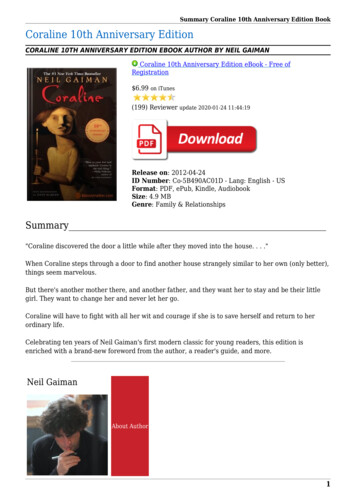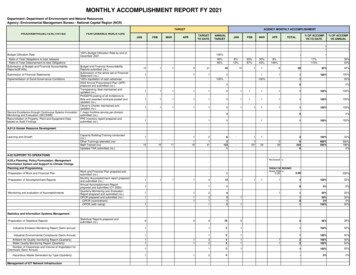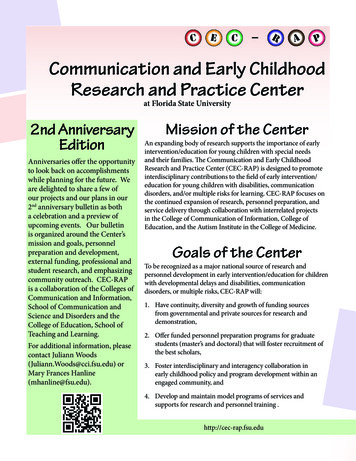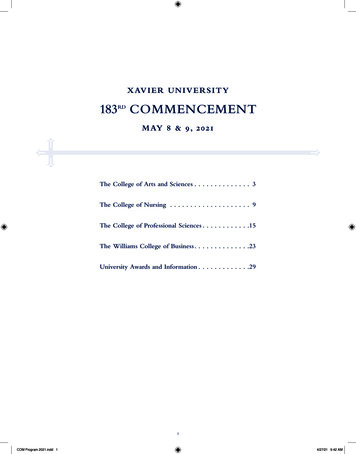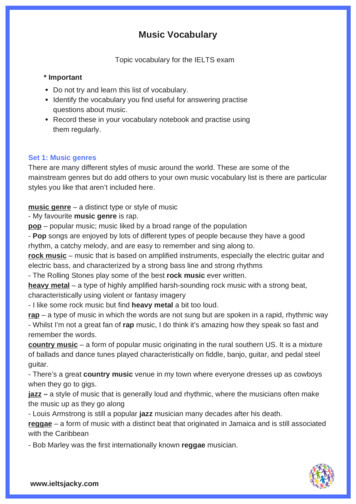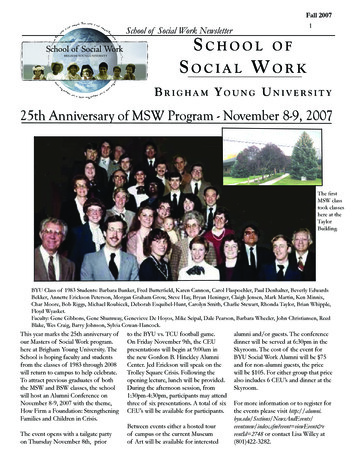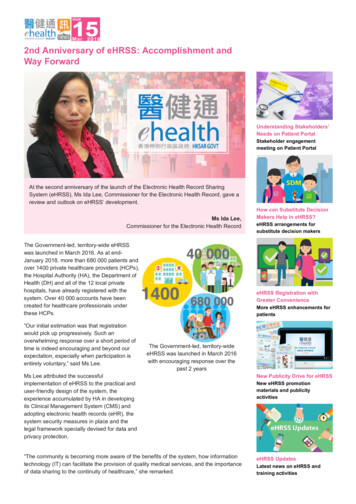
Transcription
2nd Anniversary of eHRSS: Accomplishment andWay ForwardUnderstanding Stakeholders’Needs on Patient PortalStakeholder engagementmeeting on Patient PortalAt the second anniversary of the launch of the Electronic Health Record SharingSystem (eHRSS), Ms Ida Lee, Commissioner for the Electronic Health Record, gave areview and outlook on eHRSS’ development.Ms Ida Lee,Commissioner for the Electronic Health RecordThe Government-led, territory-wide eHRSSwas launched in March 2016. As at endJanuary 2018, more than 680 000 patients andover 1400 private healthcare providers (HCPs),the Hospital Authority (HA), the Department ofHealth (DH) and all of the 12 local privatehospitals, have already registered with thesystem. Over 40 000 accounts have beencreated for healthcare professionals underthese HCPs.“Our initial estimation was that registrationwould pick up progressively. Such anoverwhelming response over a short period oftime is indeed encouraging and beyond ourexpectation, especially when participation isentirely voluntary,” said Ms Lee.How can Substitute DecisionMakers Help in eHRSS?eHRSS arrangements forsubstitute decision makerseHRSS Registration withGreater ConvenienceMore eHRSS enhancements forpatientsThe Government-led, territory-wideeHRSS was launched in March 2016with encouraging response over thepast 2 yearsMs Lee attributed the successfulimplementation of eHRSS to the practical anduser-friendly design of the system, theexperience accumulated by HA in developingits Clinical Management System (CMS) andadopting electronic health records (eHR), thesystem security measures in place and thelegal framework specially devised for data andprivacy protection.New Publicity Drive for eHRSS“The community is becoming more aware of the benefits of the system, how informationtechnology (IT) can facilitate the provision of quality medical services, and the importanceof data sharing to the continuity of healthcare,” she remarked.eHRSS UpdatesNew eHRSS promotionmaterials and publicityactivitiesLatest news on eHRSS andtraining activities
A Healthcare IT Solution with Increasing RecognitioneHRSS has been gaining not only acceptance among the local public and healthcarepractitioners, but also recognition in the information and communications technology (ICT)sector. In 2017, it won the Best Business Solution (Application) Gold Award in the HongKong ICT Awards 2017, as well as the Government and Public Sector Category WinnerAward in the Asia Pacific ICT Alliance Awards 2017. In February 2018, eHRSS once againreceived international recognition, winning the Innovative eHealth Solutions Award of theWorld Information Technology and Services Alliance Global ICT Excellence Awards 2018.“The technical design is a significant attribute,”said Ms Lee. “Yet all the more important, eHRSSprovides the essential infrastructure to support theGovernment’s healthcare reform, allowing us tomake use of an IT solution to drive and implementvarious health initiatives.”“For example, the launch of Public-PrivatePartnership (PPP) programmes can help balancethe demand for medical services in the public andprivate sectors, a situation which is unique inHong Kong where the public healthcare system isheavily relied upon. eHRSS, being theinfrastructure for record sharing among public andprivate sectors in these programmes, provides arobust foundation for implementing PPPinitiatives.”eHRSS provides a foundation forPPP programmes to help balancethe demand for medical services inthe public and private sectors“As our population ages, eHRSS helps meet themedical needs of our society by facilitating thedelivery of cross-disciplinary and sustainablehealthcare, as well as fostering public-privatecollaboration.”eHRSS Stage Two Development andChallengesIn July 2017, the Government embarked on the StageTwo Development of eHRSS with the aim to bringfurther benefits to patients and the healthcare sector.The Government embarked onthe Stage Two Developmentof eHRSS in July 2017, aimingto bring further benefits topatients and the healthcaresectorMajor areas of work include broadening the scope ofsharable data to cover radiological images andChinese medicine (CM), providing features toenhance patients’ choice over the scope of datasharing, and establishing a Patient Portal to facilitatepatients’ access to some pre-defined data in thesystem.Outlining the work of Stage Two, Ms Lee said the IT technicalities involved in sharingradiological images are particularly challenging. “We need to take into consideration thefile size, the types of records to be uploaded, and how to share and display the records,”she explained.As to CM, while the sector welcomes the idea of data sharing, the challenge is instandardising the clinical terminology and promoting computerisation of health records,said Ms Lee, adding that the sharing of CM data is likely to be launched in the later phaseof Stage Two.Fun Quiz - Chance to Win aPrize
“Terminology standardisation in CM is more complex, covering not only the diagnoses andnames of Chinese herbal medicines, but also the processing methods, medicinal parts andnames of origins. It also covers specific treatment methods associated with acupunctureand tui-na,” she said.To encourage computerisation among CM practitioners, the Government will develop aCMS On-ramp application and CMS adaptation modules for CM, and is planning to runpilots to test out CM data sharing, Ms Lee added.On the subject of enhancing patients’ choice, Ms Lee said a consultancy study has justcommenced to explore the provision of sharing restriction features and functions to beincluded in the Patient Portal, and to examine related issues including data privacy, systemsecurity and authentication.“We need to consider what are useful for patients and how the new features andfunctionalities can help patients manage their health. At the same time, we need to strike abalance between complexity in design and ease of use. If it is too complex, it will deterpatients from participating in eHRSS.”Ms Lee estimated that the Patient Portal would be implemented by phases, with basicfunctions to be offered first.Driving Further eHRSS ParticipationRegarding efforts to promote eHRSS participation, Ms Lee said the Government, apartfrom stepping up publicity, has introduced a series of enhancement measures to facilitateparticipation.“For instance, the scope of online submission has recently been expanded to enableapplications made by some substitute decision makers like parents. Patients can now alsoauthorise representatives to submit eHRSS applications. In parallel, mobile teams willcontinue to visit different community venues to help the public register with eHRSS.”“With more patients joining the system, we believe it will become a driver for HCPs’participation,” she said.“On the other hand, the launch of new PPP initiatives can be incentives for HCPs to joineHRSS, giving them the chance to experience and appreciate the benefits of eHRsharing.”In her final remark, Ms Lee said, “I truly believe eHRSS is helpful and have registeredmyself. Looking forward, there is a great deal to work on for eHRSS’ further development. Iam thankful to colleagues for their dedication and look to them for their continued support.”
Understanding Stakeholders’ Needs on PatientPortal2nd Anniversary of eHRSS:Accomplishment and WayForwardCommissioner for theElectronic Health Record oneHRSSAs part of a consultancy study, a number of engagement meetings are beingorganised in early 2018 to collect views and ideas from stakeholders on thedevelopment of the Patient Portal of the Electronic Health Record Sharing System(eHRSS). This issue of eHealth News gives a highlight of the first session attended byrepresentatives of 3 patient/ patient support groups on 8 February 2018.How can Substitute DecisionMakers Help in eHRSS?The development of a Patient Portal isone of the main work targets of theStage Two Development of eHRSS. Aconsultancy study is being conducted toreview relevant overseas experience,analyse the local environment andrecommend the development directionsand options for the Patient Portal. Inorder to build a portal that best suits thelocal healthcare environment, a series ofengagement activities has beenorganised to find out the needs,Engagement meetings are being organised toexpectations and concerns of keycollect views and ideas from stakeholders onstakeholders since early 2018.the development of the Patient PortalThe first session, held on 8 February 2018 at the Central Government Offices, wasattended by representatives of the Hong Kong Alliance of Patients’ Organisations Limited,the Society for Community Organisation and the Patients’ Alliance on Healthcare Reform.Also present were representatives from the Hospital Authority (HA) and the ElectronicHealth Record (eHR) Office.eHRSS arrangements forsubstitute decision makerseHRSS Registration withGreater ConvenienceMore eHRSS enhancements forpatientsNew Publicity Drive for eHRSSNew eHRSS promotionmaterials and publicityactivitieseHRSS UpdatesLatest news on eHRSS andtraining activities
Patient Portal: An Effective Means for Self-care and HealthManagementDuring the sharing session, participants were invited to share their valuable opinions aboutthe concept of Patient Portal as a platform to engage and empower citizens to moreeffectively manage their health and acquire health information, with a view to encouragingself-care in the community.In-depth discussions were focused on three major aspects of the Patient Portal, namelyaccess to eHRs and health information by users, value-added functions and data sharingrestriction features.Access to eHRs and Health InformationParticipants appreciated the potential capability of the future PatientPortal of enabling patients’ access to some of their eHRs andrelated health information to facilitate management of health issuesaccording to their individual healthcare needs. They particularlywelcomed the idea of integrating existing health promotioninformation from various sources into a single place. “It is hard for ageneral citizen, especially the elderly, to access and understand thefragmented health promotion information through differentchannels,” a participant remarked. “It will be great if patients caneasily obtain information about different health programmes of theGovernment (e.g. the Colorectal Cancer Screening PilotProgramme), or check his/her healthcare voucher account balanceon a single platform,” said another participant. Participants alsobelieve that patients could better communicate with their carers ifthey could access their eHRs, in particular medications and allergyinformation.While appreciating the enhanced accessibility of eHRs offered bythe Patient Portal, a few participants worried that the medicalinformation on eHRSS, especially the English medical terms, mightbe too complicated for some patients such as elders. Furthermore,there were concurring views that the ease of information accessshould be balanced with privacy risks, in particular when suchinformation might be accessed by authorised third parties such ascarers of the patients.Value-added FunctionsRegarding value-added functions to be available, representatives ofpatient support groups shared that allowing patients to input certainhealth data such as blood pressure or blood sugar measurementsthrough the Patient Portal could help enhance patients’ self-care.Patients would be encouraged to take a more active role in theirhealth management if they could make use of the Patient Portal tomonitor their health conditions or disease progress, register with theGovernment’s health programmes, and set up reminders formedication and medical appointments. Functions to authorisecarers to view some of the patients’ eHRs were also consideredhelpful not only to family members, but also non-healthcareprofessionals in the community setting in providing primary care andsupport services to patients. As all participants agreed, the ease ofauthentication and user-friendliness of the functions are the keysuccess factors of the Patient Portal.Fun Quiz - Chance to Win aPrize
Participants offered their views andsuggestions regarding the value-addedfunctions of the Patient PortalData Sharing RestrictionParticipants in general welcomed more choices for patients tocontrol the scope of data sharing, especially for those patients withsensitive medical records. Some participants, on the other hand,supported granting full access of patients’ eHRs to healthcareprofessionals, especially to doctors who could recognise patients’difficulty in deciding what kind of data to be restricted and inunderstanding the possible consequences if such data is not sharedon purpose.While respecting the rights of patients in applying certainrestrictions on data sharing, participants in general agreed thatcertain key information, such as drug allergy, should not berestricted in view of its critical importance.All in all, representatives agreed that the design of sharingrestriction features in eHRSS should not be overly complicated. Itwas preferred to be a simple function that could offer patientsstronger control and privacy protection while encouraging morepatients to join. “Public education and promulgation are essential toensure patients are well aware of their rights, obligations andimplications associated with its use,” agreed by all participants.Stakeholder EngagementWe sincerely value the views and insights from all participants.Each opinion counts for the planning, design and development ofthe Patient Portal. Further engagement with patient groups andother related sectors, such as healthcare professional bodies andrepresentatives of the information technology sector, wouldcontinue.Representatives of the Hong Kong Alliance of Patients’ Organisations Limited, theSociety for Community Organisation and the Patients’ Alliance on Healthcare Reformwere invited to attend the engagement meeting on 8 February 2018.
How can Substitute Decision Makers Help ineHRSS?2nd Anniversary of eHRSS:Accomplishment and WayForwardCommissioner for theElectronic Health Record oneHRSSEvery patient is welcome to join the Electronic Health Record Sharing System(eHRSS). What if the patient is a minor or lacks the required mental capacity to joineHRSS? Under these circumstances, an eligible substitute decision maker (SDM) mayhandle eHRSS registration matters for and on behalf of the patient.Understanding Stakeholders’Needs on Patient PortalWho will need an SDM?Stakeholder engagementmeeting on Patient PortalFor a patient who is under 16, or aged 16 or above and of any of the following,an eligible SDM can act for and on behalf of the patient for eHRSS registrationmatters Mentally incapacitated as defined by the Mental Health Ordinance (Cap.136) (MHO) s2(1);Incapable of managing his/ her own affairs;Incapable of giving joining consent at the relevant time as defined in theElectronic Health Record Sharing System Ordinance (Cap. 625)(eHRSSO); oreHRSS Registration withGreater ConvenienceMore eHRSS enhancements forpatientsIncapable of giving sharing consent at the relevant time as defined ineHRSSO.Who can be SDMs?New Publicity Drive for eHRSSFor a child aged under 16, an SDM can be-New eHRSS promotionmaterials and publicityactivitiesHis/ her parent;His/ her guardian;A person appointed by court to manage his/ her affairs;In the absence of (a) to (c), his/ her family member or aperson residing with him/ her; or(e) In the absence of (a) to (d), a prescribed healthcareprovider (HCP) who provides/ will provide healthcare tohim/ her.(a)(b)(c)(d)eHRSS UpdatesAn SDM may handleeHRSS registrationmatters for and on behalfof a patientLatest news on eHRSS andtraining activities
For an individual aged 16 or above but incapable ofgiving consent, an SDM can be(a) His/ her guardian;(b) The Director of Social Welfare or any other personqualified as guardian under MHO;(c) A person appointed by court to manage his/ her affairs;(d) In the absence of (a) to (c), his/ her family member; or aperson residing with him/ her; or(e) In the absence of (a) to (d), a prescribed HCP whoprovides/ will provide healthcare to him/ her.What matters could an SDM handle for the patient?Joining eHRSS;Giving sharing consent to individual HCPs;Managing sharing consent, including renewing, updating or revoking a sharingconsent; andRequesting for the patient’s withdrawal from eHRSS.Enhancement Measures for ApplicationsSubmitted by SDMsTo facilitate patients’ registration witheHRSS, starting from December 2017, thefollowing types of SDMs can make onlineapplication on behalf of a child or anotherpersona parent or family member of a childaged under 16, or a person residingwith the child; ora family member of an individual whois aged 16 or above but incapable ofgiving consent, or a person residingwith the individual.What are the responsibilities of an SDM?In handling eHRSS registration matters for and on behalf of a patient, an SDM is requiredto confirm that The patient meets the conditions for requiring an SDM as set out in eHRSSO;He/ she is an eligible SDM in accordance with the requirements as set out ineHRSSO;When the application is made, he/ she shall be accompanying the patient and haveregard to the patient’s best interest;He/ she shall be responsible for all matters regarding eHRSS registration for thepatient in the circumstances.SDMs are required to read the "Participant Information Notice", in particular the “ImportantNotes for SDM Handling Registration Matters on Behalf of a Healthcare Recipient” whenacting on behalf of the patient.Participant Information Notice:http://www.ehealth.gov.hk/en/healthcare recipient/participant information notice.htmlFun Quiz - Chance to Win aPrize
In the case of a parent acting as an SDM on achild’s eHRSS registration, what will happen ifthe child turns 16?When the child turns 16, consents previously given by theparent will remain valid and effective. The patient cannonetheless choose to amend his/ her registration in eHRSS atany time (e.g. to register by himself/ herself, withdraw fromeHRSS, change or revoke a sharing consent given to anHCP).For more information, please refer toRegistration for a child under 16:http://www.ehealth.gov.hk/en/healthcare recipient/registration/register child/index.htmlRegistration for an individual incapable of giving consent:http://www.ehealth.gov.hk/en/healthcare recipient/registration/register incapable person/index.htmlGiving and managing sharing consent:http://www.ehealth.gov.hk/en/healthcare recipient/registration/give sharing consent.htmlWithdrawal of re recipient/registration/withdraw registration.html
eHRSS Registration with Greater Convenience2nd Anniversary of eHRSS:Accomplishment and WayForwardCommissioner for theElectronic Health Record oneHRSSA series of enhancements has been launched from December 2017 onwards tofacilitate patients to join the Electronic Health Record Sharing System (eHRSS). Thisissue of eHealth News continues to introduce new facilitative measures.Understanding Stakeholders’Needs on Patient PortalExtended Scope of Online RegistrationStakeholder engagementmeeting on Patient PortalMore patients can now apply online for eHRSS withease and convenience. Starting from December 2017,online registration service is available for the followingtypes of applicants Hong Kong Identity Card (HKIC) HoldersHolders of other eligible identity documentsSubstitute decision maker (SDM)* registering onbehalf of a child aged under 16More patients can now applyonline for eHRSS with easeand convenienceSDM* registering on behalf of a patient aged 16 orabove but incapable of giving consent* Online application is applicable for the following typesof SDMs- Parent,- Family member or- Person residing with the patientMore details on SDM’s arrangement are at the feature article in this issue.Authorisation Online/ in WritingPlanning to join eHRSS yet unable to visitan Electronic Health Record (eHR)Registration Centre or the eHR RegistrationOffice in person? No worries. If you areaged 16 or above, you can authorise arepresentative to submit your eHRSSregistration form in person or activate youreHR for applications submitted online, byfax, post or drop-in box. To authorise arepresentative, simply fill in the requiredinformation of the authorised person whencompleting the application form.How can Substitute DecisionMakers Help in eHRSS?eHRSS arrangements forsubstitute decision makersNew Publicity Drive for eHRSSNew eHRSS promotionmaterials and publicityactivitieseHRSS UpdatesLatest news on eHRSS andtraining activitiesPatient can authorise a representative tosubmit the eHRSS registration form inperson or activate his/her eHR
When representing you to submit the eHRSS registration form or activate your eHR, theauthorised person needs to bring a copy of your identity document and his/ her ownidentity document for identity authentication. Upon completion of your registration/ recordactivation, you will receive a notification via your selected communications means (SMS/post/ email).Activation Made EasyFor patients who have submitted theireHRSS applications by not-in-personmethods (i.e. online, fax, post or drop-inbox), they need to activate their recordsbefore their eHRs can be shared ateHRSS.When you visit an eHRSS participatingclinic with your identity document for recordactivation, what if your personal informationrecorded in the system differs from youridentity document? With new enhancementmeasures in place, registration staff of theclinic can now update your particularsNew enhancement measures allowdirectly by inserting your HKIC into the card registration staff to update your particularsreader or inputting the relevant particularsdirectly by inserting your HKIC into cardmanually. Once this is completed, your eHR reader or inputting the relevant particularswill be successfully activated.manuallyFun Quiz - Chance to Win aPrize
New Publicity Drive for eHRSS2nd Anniversary of eHRSS:Accomplishment and WayForwardCommissioner for theElectronic Health Record oneHRSSA new publicity drive has commenced to promote the Electronic Health RecordSharing System (eHRSS) and encourage participation in the system.The publicity drive features a series of printedcollaterals and promotional videos prepared by theElectronic Health Record (eHR) Office to raiseawareness of eHRSS among the public and thehealthcare sector.Understanding Stakeholders’Needs on Patient PortalStakeholder engagementmeeting on Patient PortalPrinted Collaterals and PublicityTo complement the roll-out of various enhancementmeasures in December 2017, a new series of printedcollaterals introducing latest information about eHRSSis being designed and promoted through differentchannels.Public Posters –In December 2017, a new eHRSS poster wasdisplayed at over 170 designated sitesmanaged by the Information ServicesDepartment such as bus stations, pedestrianwalkways and rental housing estates forpublic’s viewing.Water Bill Inserts –Between February and May 2018, a new flyerintroducing eHRSS is being distributedthrough the Water Supplies Department aswater bill inserts, estimated to reach over 1million households in the territory.Child Registration Leaflets –In collaboration with the Department ofHealth, starting from February 2018, aspecially designed leaflet for child registrationtargeted at parents of primary 1 students isbeing distributed at the service centres of theSchool Immunisation Teams and during theirschool visits to give immunisations.How can Substitute DecisionMakers Help in eHRSS?eHRSS arrangements forsubstitute decision makerseHRSS Registration withGreater ConvenienceMore eHRSS enhancements forpatientseHRSS UpdatesLatest news on eHRSS andtraining activities
Promotional VideosTwo sets of videos, targeting the public and healthcare providers (HCPs), have beenreleased on the eHRSS website to provide user-friendly and simple illustrations about thekey concepts and operations of eHRSS. The topics include For public:- Benefits of eHRSS: benefits of eHR sharing for the general public and participantsof Public-Private Partnership (PPP) programmes- eHRSS Registration: how to join eHRSS and means of record activation- Giving Sharing Consent: what sharing consent is about and how to managesharing consent- Data Access Request and Data Correction Request: how to obtain a copy of apatient’s own eHR and raise information correction requestsFor HCPs:- Benefits of eHRSS: benefits of eHR sharing for HCPs and participating doctors ofPPP programmes- eHRSS Registration: how to register with eHRSS as HCPs and related set upprocedures- Obtaining Sharing Consent: what sharing consent is about and how to obtainpatients’ sharing consent- eHR Viewer: how to access patient’s records in the system and types ofinformation available for viewingPlease visit the eHRSS website for more videos.Fun Quiz - Chance to Win aPrize
eHRSS Updates2nd Anniversary of eHRSS:Accomplishment and WayForwardCommissioner for theElectronic Health Record oneHRSSThe Electronic Health Record Sharing System (eHRSS) has gained commendation inthe Asia-Pacific Region. To continue promotional efforts, briefings and workshopshave been organised by the Electronic Health Record Office (eHR Office) over thepast few months.Understanding Stakeholders’Needs on Patient PortalStakeholder engagementmeeting on Patient PortalWinner Award of the Government and Public Sector Category inAPICTA Awards 2017eHRSS won the Winner Awardof the Government and PublicSector Category in the AsiaPacific Information andCommunications TechnologyAlliance (APICTA) Awards2017. The award commendsoutstanding information andcommunications technology(ICT) innovation dedicated todelivering improved government Ms Ida Lee, eHRC (2nd from right),and Dr Cheung Ngai-tseung, Head ofand public sector services orInformation Technology and Healthother electronic initiatives to theInformaticsof HA (right), received thecommunity.APICTA Award in Dhaka, BangladeshMs Ida Lee, Commissioner for the Electronic Health Record (eHRC), andDr Cheung Ngai-tseung, Head of Information Technology and HealthInformatics of the Hospital Authority (HA), received the award in Dhaka,Bangladesh, on 10 December 2017.Ms Lee spoke after the award presentation ceremony, “eHRSS is animportant component of Hong Kong’s healthcare development. It helpspromote public-private collaboration, facilitate the continuity of care andimprove the quality and cost-effectiveness of healthcare services. We areglad that eHRSS is gaining increasing acceptance.”During the APICTA event, eHRSS was showcased at the Hong KongReception Night among other nominees from Hong Kong. An exhibitionbooth was set up to introduce and share experience with participants fromthe Asia-Pacific region about the concepts, development and vision of thesystem.How can Substitute DecisionMakers Help in eHRSS?eHRSS arrangements forsubstitute decision makerseHRSS Registration withGreater ConvenienceMore eHRSS enhancements forpatientsNew Publicity Drive for eHRSSNew eHRSS promotionmaterials and publicityactivities
Following the award ceremonyin Dhaka, Dr NT Cheungattended a sharing sessionhosted by the Hong KongComputer Society on 20December 2017 for localwinners in Hong Kong, wherehe shared with the audience theachievements and challengesDr NT Cheung shared about theof the eHRSS project, theachievementsand challenges of theexcitement of participating andeHRSSprojectatthe winners’ sharinggaining recognition at thesessionhostedbythe Hong KongAPICTA Awards 2017 and fromComputersocietythe community.Innovative eHealth Solutions Award in WITSA Global ICT ExcellenceAwards 2018In February 2018, eHRSS onceagain acquired internationalrecognition in the global ICTsector, winning the InnovativeeHealth Solutions Award of theWorld Information Technologyand Services Alliance (WITSA)Global ICT Excellence Awards2018.WITSA is a leading international alliance of the global ICT industryrepresenting more than 90 percent of the world ICT market. InnovativeeHealth Solutions Award commends selected individuals or organisationsthat have made remarkable and successful efforts in utilising ICT topromote health and healthcare that benefit societies, governments,organisations and the private sector.Ms Ida Lee, eHRC and Mr Hudson Chan, Senior Systems Manager(Electronic Health Systems Development) of HA, represented the Foodand Health Bureau and HA to receive the award in Hyderabad, India, on19 February 2018.More details on the award will be reported in the next issue of eHealthNews.Extension of Two Public-Private Partnership (PPP) ProgrammesRiding on the eHRSS PlatformTo facilitate sharing and the interflow of health information between publicand private healthcare providers (HCPs), participants of PPP programmesadministered by HA and the Department of Health (DH) are required toregister with eHRSS. Recently, two of these PPP programmes have beenextended, enabling more patients to benefit from eHR sharing throughthese programmes.1. Territory-wide roll-out of the General Outpatient Clinic PublicPrivate Partnership Programme (GOPC PPP)Fun Quiz - Chance to Win aPrize
The GOPC PPP was launched by HA in mid-2014 to subsidise eligiblepatients who are attending HA GOPCs to receive primary care servicesfrom the private sector. The Programme is currently covering 16 districts ofthe territory. With further extension to two more districts, namely, the Northand Yau Tsim Mong districts, in 2018/19, the Programme will cover all 18districts in Hong Kong. As at end-January 2018, more than 20 000patients have participated in the programme.Mid-2014: Kwun Tong District, Wong Tai Sin District and Tuen MunDistrict2016/17: Eastern District, Southern District, Wan Chai District,Kowloon City District, Sham Shui Po District, Kwai TsingDistrict, Sai Kung District, Sha Tin District, Yuen LongDistrict2017/
development of the Patient Portal of the Electronic Health Record Sharing System (eHRSS). This issue of eHealth News gives a highlight of the first session attended by representatives of 3 patient/ patient support groups on 8 February 2018. 2nd Anniversary of eHRSS: Accomplishment and Way Forward Commissioner for the Electronic Health Record on .

